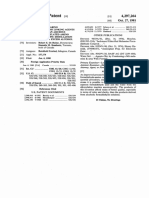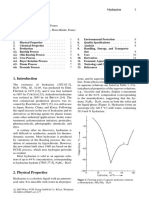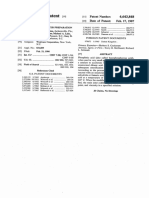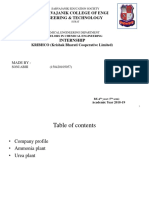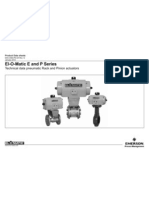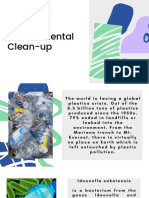0 ratings0% found this document useful (0 votes)
198 viewsSemicarbazide
Semicarbazide
Uploaded by
shenn0This patent describes a process for preparing semicarbazide hydrochloride. The process involves (1) reacting an aqueous hydrazine solution with urea at 80-130°C and a mole ratio of 0.9-1.2:1 to form semicarbazide, water, and insoluble byproducts, (2) removing water from the reaction mixture, (3) dissolving the semicarbazide in alcohol to precipitate the byproducts, (4) removing the precipitated byproducts, (5) adding HCl to the alcohol solution to form semicarbazide hydrochloride, and (6) recovering the semicarbazide hydrochloride. This process improves upon prior methods by
Copyright:
© All Rights Reserved
Available Formats
Download as PDF, TXT or read online from Scribd
Semicarbazide
Semicarbazide
Uploaded by
shenn00 ratings0% found this document useful (0 votes)
198 views3 pagesThis patent describes a process for preparing semicarbazide hydrochloride. The process involves (1) reacting an aqueous hydrazine solution with urea at 80-130°C and a mole ratio of 0.9-1.2:1 to form semicarbazide, water, and insoluble byproducts, (2) removing water from the reaction mixture, (3) dissolving the semicarbazide in alcohol to precipitate the byproducts, (4) removing the precipitated byproducts, (5) adding HCl to the alcohol solution to form semicarbazide hydrochloride, and (6) recovering the semicarbazide hydrochloride. This process improves upon prior methods by
Original Description:
semicarbazide synthesis
Original Title
semicarbazide
Copyright
© © All Rights Reserved
Available Formats
PDF, TXT or read online from Scribd
Share this document
Did you find this document useful?
Is this content inappropriate?
This patent describes a process for preparing semicarbazide hydrochloride. The process involves (1) reacting an aqueous hydrazine solution with urea at 80-130°C and a mole ratio of 0.9-1.2:1 to form semicarbazide, water, and insoluble byproducts, (2) removing water from the reaction mixture, (3) dissolving the semicarbazide in alcohol to precipitate the byproducts, (4) removing the precipitated byproducts, (5) adding HCl to the alcohol solution to form semicarbazide hydrochloride, and (6) recovering the semicarbazide hydrochloride. This process improves upon prior methods by
Copyright:
© All Rights Reserved
Available Formats
Download as PDF, TXT or read online from Scribd
Download as pdf or txt
0 ratings0% found this document useful (0 votes)
198 views3 pagesSemicarbazide
Semicarbazide
Uploaded by
shenn0This patent describes a process for preparing semicarbazide hydrochloride. The process involves (1) reacting an aqueous hydrazine solution with urea at 80-130°C and a mole ratio of 0.9-1.2:1 to form semicarbazide, water, and insoluble byproducts, (2) removing water from the reaction mixture, (3) dissolving the semicarbazide in alcohol to precipitate the byproducts, (4) removing the precipitated byproducts, (5) adding HCl to the alcohol solution to form semicarbazide hydrochloride, and (6) recovering the semicarbazide hydrochloride. This process improves upon prior methods by
Copyright:
© All Rights Reserved
Available Formats
Download as PDF, TXT or read online from Scribd
Download as pdf or txt
You are on page 1of 3
' United States Patent [19] [11] Patent Number: 4,482,738
Rothgery [45] Date of Patent: Nov. 13, 1984
[54] PROCESS FOR PREPARING ‘ Primary Examiner—Thomas A. Waltz
SEMICARBAZIDE HYDROCHLORIDE Attorney, Agent, or Firm—William A. Simons; Thomas
[75] Inventor: Eugene F. Rothgery, North Branford, P. O’Day
Conn. [57] ABSTRACT .
[73] Assignee: Olin Corporation, Cheshire, Conn. A process for preparing semicarbazide hydrochloride
[21] Appl. No.: 519,471 comprising the steps:
(a) reacting an aqueous hydrazine solution with urea
[22] Filed: Aug. 1, 1983 at a temperature from about 80° C. to about 130° C.
[51] Int. c1.3 .......................................... .. C07C 133/02 and at a mole ratio of hydrazine to urea from about
[52] US. Cl. ...... . . . . . . . . . . .. 564/37; 564/18; 0.9:1 to about 1.2:1 to form a reaction mixture com
564/34; 564/35 prising semicarbazide, water and alcohol-insoluble
[58] Field of Search ...................... .. 564/18, 34, 35, 37 by-products;
[56] References Cited (b) removing substantially all of the water from the
reaction mixture;
U.S. PATENT DOCUMENTS (0) mixing a suf?cient amount of an alcohol with the
Re. 24,526 8/1958 Sampson, Jr. ..................... .. 260/554 water-deleted reaction mixture to dissolve the
564/35 semicarbazide and to precipitate said alcohol
2,749,217
2,692,281 10/1954
6/1956 Deutschman,
Newby et al. Jr. 23/190 insoluble by-products from the resulting alcohol
3,227,753 1/1966 Mehr et a1. ......................... .. 564/35
solution;
FOREIGN PATENT DOCUMENTS (d) removing said precipitated alcohol-insoluble by
848167 9/1960 United Kingdom ................ .. 564/37
products from said alcohol solution;
(6) adding a suf?cient amount of anhydrous hydrogen
OTHER PUBLICATIONS chloride to said alcohol solution to form and pre
Charles Clark, Hydrazine, Mathieson Chemical Corpo cipitate semicarbazide hydrochloride; and
ration, pp. 59-63, (1953). . (f) recovering said semicarbazide hydrochloride from
Mistry et al., J. Ind. Chem. Soc., vol. 7, p. 793, (1930). said alcohol solution.
Das-Gupta, J. Ind. Chem. Soc., vol. 10, p. 111, (1933).
Wheeler, JACS, 51, 3654, (1929). 8 Claims, No Drawings
4,482,738
1 2
(t) recovering the semicarbazide hydrochloride from
PROCESS FOR PREPARING SEMICARBAZIDE the alcohol solution.
HYDROCHLORIDE DETAILED DESCRIPTION
BACKGROUND OF THE INVENTION The formation- of semicarbazide hydrochloride from
1. Field of the Invention urea, hydrazine and HCl is illustrated by the following
The present invention relates to a process for prepar equations (A) and (B):
ing semicarbazide hydrochloride.
2. Description of the Prior Art 10
semicarbazide hydrochloride is an important hydra
zine-based chemical intermediate used in the production
of pharmaceuticals, photographic chemicals and other
products. This compound has been preparedby a vari
ety of synthesis routes. One preparation method in
volves reacting carbon monoxide with hydrazine at
superatmospheric pressures and at temperatures in the The reactants for this process are widely available
range from 0° C. to 200° C. and in the presence of a chemicals. Urea is a widely available commodity chemi
catalytic amount of a metal carbonyl to obtain semicar cal. Hydrazine is also commonly available in the form of
bazide which was acidi?ed to yield the desired salt. See 20 hydrazine hydrate (an aqueous solution‘ containing 1
US. Pat. Reissue No. 24,526, which reissued to H. J. mole hydrazine and 1 mole H2O or 64% by weight
Sampson, Jr. on Aug. 26, 1958. hydrazine). It is also available in other aqueous solutions
Another method involves reacting nitrourea with (e.g. solutions containing from about 95% to about 5%
hydrogen in the presence of a hydrogenation catalyst, by weight hydrazine). Hydrazine hydrate is the pre
hydrochloric acid and an inert solubilizing agent to 25 ferred source of hydrazine for this process.
produce semicarbazide hydrochloride. See U.S. Pat. It is critical to the present process to employ anhy
No. 2,749,217, which issued to A. J. Deutschman, Jr. on drous HCl. It has been found that employment of anhy
June 5, 1956. drous HCl instead of the more commonly available
A preferred commercial route involves the reaction aqueous solutions of HCl signi?cantly increases the
of hydrazine hydrate (64% by weight hydrazine) with 30 product yield. The term “anhydrous HCl” as employed
urea. At the end of the reaction, the water and unre herein includes HCl solutions which contain less than
acted hydrazine from the hydrazine solution is stripped. about 2% by weight H2O.
The reaction mixture is then digested in methanol fol The mole ratio of hydrazine to urea, as stated above,
lowed by ?ltering off methanol-insoluble by-products should be from about 0.9:1 to about 1.2:1. The employ
(e.g. hydrazodicarbonamide). The remaining ?ltrateis 35 ment of this range of mole ratios is important because
acidi?ed with aqueous hydrochloric acid to precipitate low yields of product would be obtained if a sigini?cant
semicarbazide hydrochloride which is then recovered. excess of hydrazine was employed and the formation of
This latter route, while being advantageous in being the by-product, hydrazodicarbonamide, is favored with
able to use atmospheric pressure reactions and inexpen signi?cant excess of urea. It is more preferred to employ
sive reactants, does have the disadvantage of having 40 a hydrazine to urea mole ratio from about 0.95:1 to
relatively low yields (i.e. about 75% to 80% based on about 1.1:1.
' the urea used). Accordingly, there is a need in the art to The reaction temperature should be from about 80°
be able to improve the yields of thisprocess without C. to about 130° C. in order to achieve the reasonable
substantially increasing its costs. The present invention reaction rate. The reaction rate appears to slow down
is believed to be a solution to that need. signi?cantly below about 80° C. Above about 130° C.,
degradation reactions are initiated which lower the
BRIEF SUMMARY OF THE INVENTION product yield and complicates its recovery. Preferably
The present invention, therefore, is directed to a the reaction should be carried out to about 100° C. to
process for making semicarbazide hydrochloride com about 120° C. The reaction time is dependent upon the
prising the steps of: 50 reaction temperature and with higher temperatures a
(a) reacting an aqueous hydrazine solution with urea shorter time would be needed. The present invention
at a temperature from about 80° C. to about 130° C. does not require the use of either sub- or superatmos
and at a mole ratio of hydrazine to urea from about pheric pressures during the reaction. It is preferred to
0.9:1 to about 1.2:1 to form a reaction mixture com use atmospheric pressure reactors of conventional con
prising semicarbazide,-water and alcohol-insoluble 55 struction. It should be noted that ammonia is evolved as
by-products; ' a by-product during the reaction and minute amounts of
(b) removing substantially all (i.e. at least about 95% ammonia may be still present at the end of the reaction.
by weight) of the water from the reaction mixture; However, these may usually be removed with the wa
(0) mixing a suf?cient amount of an alcohol with the ter.
water-deleted reaction mixture to dissolve the After the reaction is complete, it is ‘necessary to re
semicarbazide and to precipitate the alcohol move substantially all of the water in the reaction mix
insoluble by-products from the resulting alcohol ture which originated with the aqueous hydrazine solu
solution; tion. This water removal step can be carried out by any
(d) removing the precipitated alcohol-insoluble by conventional means. Vacuum distillation is the pre
products from the alcohol solution; 65 ferred technique for removing water. Excess hydrazine
(e) adding a suf?cient amount of anhydrous hydrogen and ammonia will also be removed by this step. In a
chloride to the alcohol solution to form and precip preferred embodiment, at least about 98% by weight of
itate semicarbazide hydrochloride; and the H20 is removed by this step.
4,482,738
3 4
Upon completion of the water removal step the wa theory based on urea charged and assaying 97.8% pure
ter-deleted residue (i.e. containing semicarbazide and by NaOH titration. '
alcohol-insoluble by'-products such as hydrazodicar Comparing the product yield of Example I to Com
bonamide) is mixed with an alcohol to preferentially parison I, one can readily see that the process of the
dissolve substantially all of the semicarbazide and pre 5 present invention produces a signi?cantly higher yield.
cipitate substantially all of the alcohol-insoluble by-pro What is claimed is:
ducts. Any of the lower alcohols'having l-4 carbon 1. A process for making semicarbazide hydrochloride
atoms such as methanol ethanol, isopropanol and the comprising the steps of:
like are preferred. It is more preferred to use methanol (a) reacting an aqueous hydrazine solution with urea
because of the higher solubility of semicarbazide in it. It at a temperature from about 80° C. to about 130° C.
may also be preferable to heat this mixture (e.g. to about and at a mole ratio of hydrazine to urea from about
55° C. to about 65° C.) in order to achieve greater solu 0.9:1 to about 1.221 to form a reaction mixture com
bility of the semicarbazide. Also the mixture may be prising semicarbazide, water and alcohol-insoluble
agitated for the same purpose. The preferred amount of by-products;
alcohol added is at least equal by weight to the amount (b) removing substantially all of the water from the
of the water-deleted reaction mixture. 15
When the alcohol-insolubles are completely settled or reaction mixture;
(0) mixing a suf?cient amount of an alcohol with the
precipitated from the solution, they may be removed by water-deleted reaction mixture to dissolve said
any conventional means. Filtration is preferred al
though other conventional techniques, such as centrifu semicarbazide and to precipitate said alcohol
gation and the like, may be used‘ instead. 20 insoluble by-products from the resulting alcohol
After separation of the insolubles, the clari?ed alco solution;v
holic mixture is acidi?ed with anhydrous HCl to form (d) removing said precipitated alcohol-insoluble by
the desired semicarbazide hydrochloride product. The products from said alcohol solution;
preferred amount of HCl added should be approxi (e) adding a suf?cient amount of anhydrous hydrogen
mately a 1:1 mole ratio with the semicarbazide.Prefera 25 chloride to said alcohol solution to form and pre
bly, the anhydrous acid is added slowly into the alco cipitate semicarbazide hydrochloride; and
holic mixture. This addition of the HCl forms a precipi (f) recovering said semicarbazide hydrochloride from
tate which is the desired product. said alcohol solution.
The precipitated semicarbazide hydrochloride may 2. The process of claim 1 wherein said aqueous hy
be recovered from the alcoholic mixture by any con drazine solution is hydrazine hydrate.
ventional means. Again ?ltration is the preferred tech 3. The process of claim 1 wherein the reaction tem
nique although other conventional techniques may be perature for step (a) is from about 105° C. to about 120°
used. After removal of the alcoholic mixture from the C.
product, the product may be washed in methanol and 4. The process of claim 1 wherein the mole ratio of
dried for use in other processes. hydrazine to urea is from about 0.95:1 to about 1.1:1.
The following example and comparison further illus 35 5. The process of claim 1 wherein said alcohol is a
trate the present invention. All parts and percentages lower alcohol having 1 to 4 carbon atoms.
are by weight unless explicity stated otherwise. 6. The process of claim 5 wherein said lower alcohol
is methanol.
EXAMPLE I 7. The process of claim 1 wherein the amount of
Use of Anhydrous Acid Conditions hydrogen chloride added in step (e) is approximately an
Urea (60.1 g, 1 mole) and 64% aqueous hydrazine equal molar amount to the semicarbazide present in said
solution (55 g, 1.10 moles) were placed in a 250 ml, alcohol solution.
3-neck ?ask and heated at re?ux (ll5°—120° C.) for 8. A process for making semicarbazide hydrochloride
three hours evolving gaseous ammonia. At the end of 45 comprising the steps of:
the reaction period, the excess hydrazine and accompa (a) reacting hydrazine hydrate with urea at a temper
nying water were vacuum stripped at 70° C. and 10 ature from about 100° C. to about 120° C. and at a
torr, leaving semicarbazide and by-products including mole ratio of hydrazine to urea from about 0.95:1 to
hydrazodicarbonamide. These were separated by di about 1.1:1 to form a reaction mixture comprising
gesting in 200 ml of boiling methanol for 45 minutes and semicarbazide, water and methanol-insoluble by
filtering off the insoluble hydrazodicarbonamide (5.5 g). products;
The ?ltrate was cooled to 10° C. and a solution of 37 g (b) removing substantially all of the water from the
(one mole) of anhydrous hydrogen chloride in 65 ml of reaction mixture;
methanol added. The product precipitated, was ?ltered (0) mixing a suf?cient amount of methanol with the
off, washed with 50 ml of methanol and dried to give water-deleted reaction mixture to dissolve said
100 g of semicarbazide hydrochloride-89.7% of the semicarbazide and to precipitate said methanol
ory based on urea charged and assaying 97.6% by insoluble by-products from the resulting methanol
NaOH titration. solution;
Comparison I (d) ?ltering said precipitated methanol-insoluble by
products from said methanol solution;
Use Of Aqueous Acid Conditions (e) adding anhydrous hydrogen chloride to said
Urea and 64% hydrazine were reacted on the same methanol solution to form and precipitate semicar
scale and conditions as in Example I, except that after bazide hydrochloride, the amount of said hydrogen
digesting the mixture and ?ltering away the hy chloride added being approximately an equal molar
drazodicarbonamide, 98 g of 37% aqueous hydrochlo amount to the semicarbazide present in the metha
ric acid (1 mole) was added to precipitate the semicar 65 nol solution; and '
bazide hydrochloride. The product was ?ltered from (f) ?ltering said semicarbazide hydrochloride from
the methanol/water solution, washed with methanol said methanol solution.
and dried to give 862 g, which represents 77.3% of ill it * I.‘ \l‘
You might also like
- Grade 11 Earth Science Week 5 LASDocument16 pagesGrade 11 Earth Science Week 5 LASDondon Tayaban100% (1)
- United States PatentDocument4 pagesUnited States Patentwiam wiamNo ratings yet
- Patent US4317926Document9 pagesPatent US4317926Santiago BorgesNo ratings yet
- US3983180Document7 pagesUS3983180Agustina TriyaniNo ratings yet
- Process For The Manufacture of Citric Acid Esters of Partial Fatty Acid GlyceridesDocument3 pagesProcess For The Manufacture of Citric Acid Esters of Partial Fatty Acid GlyceridesHarry CortezNo ratings yet
- US4582892Document8 pagesUS4582892Sayyed Abdul QayyumNo ratings yet
- Us2537791 Hydrazine HydrateDocument3 pagesUs2537791 Hydrazine HydrateTeleson MarquesNo ratings yet
- Us 4378342Document9 pagesUs 4378342هیمن مNo ratings yet
- US3923967Document9 pagesUS3923967nicoNo ratings yet
- Us 4501923Document5 pagesUs 4501923sir.jieranmorotNo ratings yet
- Preparation of Cupric HydroxideDocument5 pagesPreparation of Cupric HydroxideAnonymous PdsQnCAyNo ratings yet
- Patent US3926744Document8 pagesPatent US3926744Santiago BorgesNo ratings yet
- @ Gradeff US3869517 1975 Process For Preparing Hydroxy Citronellal Via 1,1-DiacetatesDocument10 pages@ Gradeff US3869517 1975 Process For Preparing Hydroxy Citronellal Via 1,1-DiacetatesLouisNo ratings yet
- Patent - 1978 - US4076589 - Process For The Production of (DHA)Document4 pagesPatent - 1978 - US4076589 - Process For The Production of (DHA)Lucas CoêlhoNo ratings yet
- Us 6288289Document16 pagesUs 6288289ade sefliaNo ratings yet
- 0173NF2016 Fo2c PDFDocument26 pages0173NF2016 Fo2c PDFRadhakrishna MadabhushiNo ratings yet
- US4207351Document10 pagesUS4207351Diego RossoNo ratings yet
- United States Patent PO: Patented Nov. 20, 1956Document2 pagesUnited States Patent PO: Patented Nov. 20, 1956shenn0No ratings yet
- US4555564Document7 pagesUS4555564Narayana mahantyNo ratings yet
- +supersaturation ValuesDocument5 pages+supersaturation ValuesAhmad NaeemNo ratings yet
- United States Patent: (73) Assignee Sidney Cooke Chemicals Pty. Ltd. Assistant Examiner-Sidney MarantzDocument4 pagesUnited States Patent: (73) Assignee Sidney Cooke Chemicals Pty. Ltd. Assistant Examiner-Sidney MarantzAti Devara RachmawatiNo ratings yet
- TCCA - US3898222 - P - Process For Preparing Trichloroisocyanuric AcidDocument3 pagesTCCA - US3898222 - P - Process For Preparing Trichloroisocyanuric AcidListya Eka AnggrainiNo ratings yet
- A Convenient Preparation of Volatile Acid ChloridesDocument4 pagesA Convenient Preparation of Volatile Acid ChloridesScott SwartzNo ratings yet
- United States Patent Office: Patented Jan. 23, 1973Document2 pagesUnited States Patent Office: Patented Jan. 23, 1973Ahmad DawamNo ratings yet
- KKKK Us4297264Document4 pagesKKKK Us4297264هیمن مNo ratings yet
- Peroxide ProcessDocument10 pagesPeroxide ProcessAdrian Bermudez LoeraNo ratings yet
- US20140296592A1Document9 pagesUS20140296592A1Ebrahim KazemiNo ratings yet
- US5354545Document6 pagesUS5354545Joel de la BarreraNo ratings yet
- ' Umted States Patent (19) (11) Patent Number: 4,954,330 Ziegenhain (45) Date of Patent: Sep. 4, 1990Document4 pages' Umted States Patent (19) (11) Patent Number: 4,954,330 Ziegenhain (45) Date of Patent: Sep. 4, 1990Waheed ZebNo ratings yet
- F8306256Process TechnologyDocument5 pagesF8306256Process TechnologyShubham SinghNo ratings yet
- Patent Pabrik Pthalic Anhydride Proses Von HeydenDocument7 pagesPatent Pabrik Pthalic Anhydride Proses Von HeydenFaizhal DimazNo ratings yet
- Production of Sodium DithioniteDocument10 pagesProduction of Sodium DithioniteDhaval PadaliaNo ratings yet
- Patent US4364917 Mantap PDFDocument4 pagesPatent US4364917 Mantap PDFTius TanNo ratings yet
- US3983032Document4 pagesUS3983032Diego RossoNo ratings yet
- United States Patent (19) : Barcelona, Jr. (45) Date of Patent: Nov. 17, 1992Document3 pagesUnited States Patent (19) : Barcelona, Jr. (45) Date of Patent: Nov. 17, 1992AMAN KEJAYANo ratings yet
- CASE STUDY CMT650 GROUP 2 - Najib RashidDocument17 pagesCASE STUDY CMT650 GROUP 2 - Najib RashidsaifulddinNo ratings yet
- US4094913Document4 pagesUS4094913Ranjana MadabushiNo ratings yet
- Schirmann 2001Document18 pagesSchirmann 2001Mencyn Michelle Kellie EbreoNo ratings yet
- Patente 01 US6309621Document7 pagesPatente 01 US6309621igiliNo ratings yet
- 1,2 DibromocyclohexaneDocument2 pages1,2 DibromocyclohexaneJames StreetNo ratings yet
- Oct. 28, 1958 R. M. Thomas Etal 2,858,345: Filed March 30, 1956Document3 pagesOct. 28, 1958 R. M. Thomas Etal 2,858,345: Filed March 30, 1956Poetri RagafadmiNo ratings yet
- Us 4317781Document3 pagesUs 4317781Wojciech RedutkoNo ratings yet
- Hidrólisis Ácida de CarbohidratosDocument9 pagesHidrólisis Ácida de CarbohidratosVíctor YanalaNo ratings yet
- (2014) US8841445 Process For Preparing Purified Caprolactam From The Beckmann RearrangementDocument6 pages(2014) US8841445 Process For Preparing Purified Caprolactam From The Beckmann RearrangementThitikorn WassanarpheernphongNo ratings yet
- Professor/ Ahmed Soliman: Technical Report AboutDocument30 pagesProfessor/ Ahmed Soliman: Technical Report Aboutmhmod.daod.1No ratings yet
- CHP Cleavage by Shell MarkedDocument6 pagesCHP Cleavage by Shell MarkedHARSH DHOLAKIYANo ratings yet
- Process For Purification of HCL From Edc PyrolysisDocument6 pagesProcess For Purification of HCL From Edc Pyrolysisu2051721No ratings yet
- United States Patent (19) : MitchellDocument4 pagesUnited States Patent (19) : Mitchellrichris orvanidisNo ratings yet
- US5352424Document5 pagesUS5352424Ipalma 3No ratings yet
- Us 3607021Document4 pagesUs 3607021haviedNo ratings yet
- United States Patent: ABSTRACT: A Free-Flowing Crystalline Noncaking TrisodiumDocument3 pagesUnited States Patent: ABSTRACT: A Free-Flowing Crystalline Noncaking Trisodiumkamil_vidNo ratings yet
- c1Document13 pagesc1Ngua GiaNo ratings yet
- Hidrazina PDFDocument18 pagesHidrazina PDFPedddro96100% (1)
- HYDRAZINEDocument19 pagesHYDRAZINEDamla Taykoz100% (2)
- 10.1.polendo (Additional Patent)Document11 pages10.1.polendo (Additional Patent)Rima AmaliaNo ratings yet
- Us4018815 PDFDocument4 pagesUs4018815 PDFFatih AkmanNo ratings yet
- Us4643848 Fumaric RosinDocument5 pagesUs4643848 Fumaric RosinPudien MuhamadNo ratings yet
- Patent Pabrik Phenyl Ethyl AlcoholDocument6 pagesPatent Pabrik Phenyl Ethyl AlcoholFaizhal DimazNo ratings yet
- Water Softening with Potassium Chloride: Process, Health, and Environmental BenefitsFrom EverandWater Softening with Potassium Chloride: Process, Health, and Environmental BenefitsNo ratings yet
- Fuels, Chemicals and Materials from the Oceans and Aquatic SourcesFrom EverandFuels, Chemicals and Materials from the Oceans and Aquatic SourcesFrancesca M. KertonNo ratings yet
- Synthetic Natural Gas: From Coal, Dry Biomass, and Power-to-Gas ApplicationsFrom EverandSynthetic Natural Gas: From Coal, Dry Biomass, and Power-to-Gas ApplicationsTilman J. SchildhauerNo ratings yet
- Balestrero 1986Document4 pagesBalestrero 1986shenn0No ratings yet
- Chapter 1Document27 pagesChapter 1shenn0No ratings yet
- OK OF Cinkanaldehyde: AllasDocument5 pagesOK OF Cinkanaldehyde: Allasshenn0No ratings yet
- Us PatentDocument3 pagesUs Patentshenn0No ratings yet
- 1-3 DiketoneDocument4 pages1-3 Diketoneshenn0No ratings yet
- Solvent MiscibilityDocument1 pageSolvent MiscibilityTanize LimaNo ratings yet
- United States Patent PO: Patented Nov. 20, 1956Document2 pagesUnited States Patent PO: Patented Nov. 20, 1956shenn0No ratings yet
- n-BUTANOL Technical Information - BPC PDFDocument4 pagesn-BUTANOL Technical Information - BPC PDFshenn0No ratings yet
- AlSayyab Ostevens Schiffbases 2 Thermal Decarboxylation Aminoacids KetonesDocument5 pagesAlSayyab Ostevens Schiffbases 2 Thermal Decarboxylation Aminoacids Ketonesshenn0No ratings yet
- Biginille Reaction Mechanism PDFDocument4 pagesBiginille Reaction Mechanism PDFshenn0No ratings yet
- The Synthesis of Cinnamoyl Chloride: Tadao MatsumotoDocument5 pagesThe Synthesis of Cinnamoyl Chloride: Tadao Matsumotoshenn0No ratings yet
- Nitrogen Carbon HydrogenDocument6 pagesNitrogen Carbon Hydrogenshenn0No ratings yet
- Soliwoda 2014Document6 pagesSoliwoda 2014shenn0No ratings yet
- Laboratory Test For HydrocarbonsDocument2 pagesLaboratory Test For HydrocarbonsdhonaNo ratings yet
- Acid Value of OilDocument20 pagesAcid Value of OilFavourNo ratings yet
- A Developed Process For The Synthesis of 2 Ethyl Phenyl Hydrazine Hydrochloride A Key Starting Material For 7 Ethyl Tryptophol PDFDocument4 pagesA Developed Process For The Synthesis of 2 Ethyl Phenyl Hydrazine Hydrochloride A Key Starting Material For 7 Ethyl Tryptophol PDFRanjana Madabushi100% (2)
- SLG Chem 3 LG 5.4 Pka and The Isoelectric Point PiDocument5 pagesSLG Chem 3 LG 5.4 Pka and The Isoelectric Point PifranzachilleslindayagNo ratings yet
- Study On Pu SoleDocument4 pagesStudy On Pu Solesusan mishraNo ratings yet
- Nutrisi Parenteral: Asering Kaen 1B Kaen 3A Kaen 3B Kaen Mg3 Kaen 4A Kaen 4BDocument2 pagesNutrisi Parenteral: Asering Kaen 1B Kaen 3A Kaen 3B Kaen Mg3 Kaen 4A Kaen 4BResti adNo ratings yet
- 5991 6142enDocument18 pages5991 6142enAlexandre ChidaNo ratings yet
- Sarvajanik College of Engi Neering & Technology: KRIBHCO (Krishak Bharati Cooperative Limited)Document14 pagesSarvajanik College of Engi Neering & Technology: KRIBHCO (Krishak Bharati Cooperative Limited)yagnaNo ratings yet
- Teaching 922 18783 1613332733 1Document39 pagesTeaching 922 18783 1613332733 1Stark JohnNo ratings yet
- Dispersedyesfullpdf 210811091252Document19 pagesDispersedyesfullpdf 210811091252yonasNo ratings yet
- Dse PN MetricDocument29 pagesDse PN MetricSuman DeyNo ratings yet
- D 297 - 93 R98 Rdi5ny05m1i5oa - PDFDocument37 pagesD 297 - 93 R98 Rdi5ny05m1i5oa - PDFMaick Steven Arriaga SandiNo ratings yet
- Chapter 11 The Group 1 ElementsDocument8 pagesChapter 11 The Group 1 Elementsbryant021593No ratings yet
- Kling 2017Document63 pagesKling 2017jainigNo ratings yet
- AR Practice Sheet - GOC - Arjuna NEET 2024Document3 pagesAR Practice Sheet - GOC - Arjuna NEET 2024conservativerajputraNo ratings yet
- SGOT ASAT Kit Reitman Frankel MethodDocument3 pagesSGOT ASAT Kit Reitman Frankel MethodShribagla MukhiNo ratings yet
- EP15712059NWB1Document15 pagesEP15712059NWB1rezaNo ratings yet
- Astm D7637-10 (2021)Document4 pagesAstm D7637-10 (2021)Anju DoraisamyNo ratings yet
- Chemistry: PAPER 3 Practical TestDocument8 pagesChemistry: PAPER 3 Practical TestTawandaNo ratings yet
- Environmental Clean-Up: Group 5-BiologyDocument8 pagesEnvironmental Clean-Up: Group 5-BiologyTrexi Mag-asoNo ratings yet
- EXM Powder Paint Coatings Color Chart EngDocument1 pageEXM Powder Paint Coatings Color Chart EngHomero BasalduaNo ratings yet
- Chemistry 9th Class Chaper 1 PDFDocument13 pagesChemistry 9th Class Chaper 1 PDFUmme Abdullah50% (2)
- Efek MDM BeefDocument6 pagesEfek MDM BeefGatut SulianaNo ratings yet
- ProductsDocument64 pagesProductsDaniele SantosNo ratings yet
- Polymer Exam 2222Document8 pagesPolymer Exam 2222wondimuNo ratings yet
- Acid Hydrolysis of Sugarcane Bagasse For Lactic Acid ProductionDocument8 pagesAcid Hydrolysis of Sugarcane Bagasse For Lactic Acid ProductionAndressaGonçalvesNo ratings yet
- Adv. Prev + Extra Edge 68-74 (Exercise 5 & 6)Document7 pagesAdv. Prev + Extra Edge 68-74 (Exercise 5 & 6)Aditya ShahNo ratings yet
- 6 A.cotton, Coir, Kapok PDFDocument31 pages6 A.cotton, Coir, Kapok PDFanushkaNo ratings yet
- Jurnal Kimia Mulawarman Volume15 Nomor1November2017 Kimia FMIPA Unmul P-ISSN 1693-5616 E-ISSN 2476-9258Document10 pagesJurnal Kimia Mulawarman Volume15 Nomor1November2017 Kimia FMIPA Unmul P-ISSN 1693-5616 E-ISSN 2476-9258yulida anggrainiNo ratings yet
























